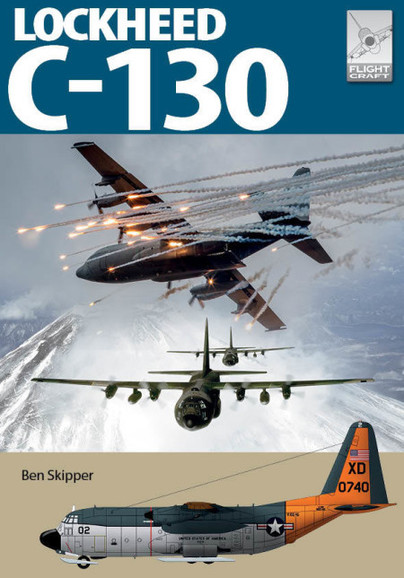Author Guest Post: Ben Skipper
Flight Craft 32: Lockheed Martin C-130 Hercules
If ever there was an aeroplane so deserving of the accolade of being the most recognisable symbol of heavy airlift, then it has to be the often copied, but never beaten, Lockheed Martin C-130 Hercules. Designed at a time when the turbojet was deemed to be the motive power for all future military aircraft, the Lockheed design team convinced the Military Air Transport Service (MATS) and Tactical Air Commands (TAC) that a turboprop-designed aircraft was what they wanted. For the USAF, in particular, the use of Second World War vintage aircraft in the recently concluded Korean War had shown their airlift flight lines to be already outdated. It would also sharpen MATS and TAC’s focus considerably as to the type of platform they needed.
For the USAF, the next generation airlifter had to be as versatile as the new helicopters, whose presence in the battle space was increasing, have a range of aircraft such as the B-24 and B-29, and the robust characteristics of the B-17. While Fairchild’s C-119 and Douglas’s C-124 were available, neither were the everyman MATS and TAC needed. Although a popular and capable aeroplane, the C-119 was hampered by its low range and capacity. The C-124 had been earmarked to make full use of its prodigious payload capacity and, more importantly, its spacious cargo deck that was best suited to service the ever-growing needs of a Special Weapon (Atomic) based Strategic Air Command and the Armed Forces Special Weapons Project (AFSWP). The latter was responsible for maintaining, storing, surveillance, security and handling America’s special weapons.
With defence spending being more rigidly applied, the available money was poured into strategic air assets such as the B-36 and B47. This left any company wanting to take the lead in developing tomorrow’s tactical medium airlifter doing so on a shoestring. It would be Lockheed, whose experience in developing the L-749 and later the L-1049 Constellation family of airliners, allied to its work on the long-range, high capacity R6V Constitution, who would attempt to meet the General Operational Requirement (GOR) of February 1951. Guided by Lieutenant-General Gordon Saville’s (USAF) thoughts, Lockheed dispatched Al Lechner and Chuck Burns to learn more about what was needed and how it would be used. This allowed Lockheed to build a reliable picture of how ergonomic needs would meet strategic desires.
Lechner and Burns completely understood what the USAF wanted and, perhaps more importantly, what the army needed. On 23 August 1953, the new YC-130 made its maiden flight from the Lockheed plant in Burbank, California. The new aeroplane featured a distinct nose that was the most prominent departure from transport aircraft design; the Roman nose would soon alter with the addition of avionics, giving the series production C-130 its distinct forward profile. The new cockpit would be home to the pilot, co-pilot, flight engineer and navigator; it was extensively glazed and came complete with floor-level windows to aid low-flying observation.
Within a decade, the C-130 was fulfilling a range of operational tasks globally, proving Lockheed’s design was successful and evergreen. There would be modest changes to the C-130 as it progressed through its key variants in the 40 years between its adoption into service in 1956 and the unveiling of the J, or Super Hercules, in 1996. In that period, the C-130 had entered service with over 50 countries, was released as a civil version (L-100 series), and became synonymous as a military airlifter. From air assault platform to fire support, fire-fighting to refugee evacuation, the C-130 out-performed itself repeatedly, gaining accolades in the crew room and the skies.
Even as newer, larger and more advanced airlifters have taken to the skies, the C-130 has happily plodded along in its own demure, utilitarian way, bringing smiles of enjoyment and sighs of relief, depending on the mission. Its friendly visage has hidden a strength that Hercules himself would have been proud of and a longevity that may well see the C-130 reach its Centenary of service in a mere 30 years’ time.
For the modeller, the C-130 represents an essential step in aviation history and aeronautical engineering and the opportunity to create exciting dioramas or colourful vignettes. For the aviation enthusiast, this title is designed to deliver a concise history of an aviation legend and do justice to its checked service and many variants that have graced the flight lines over the years.

Order your copy here.

